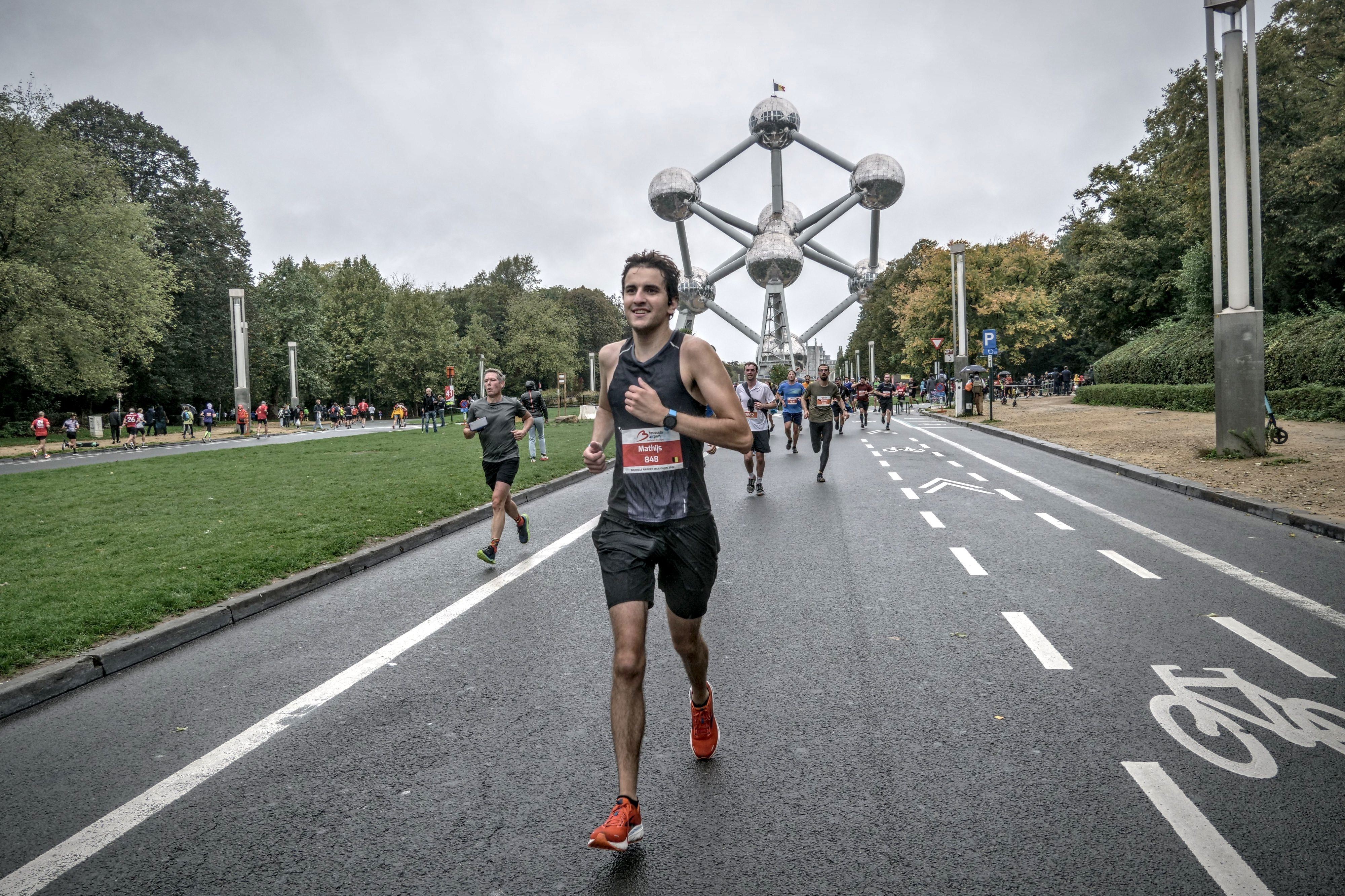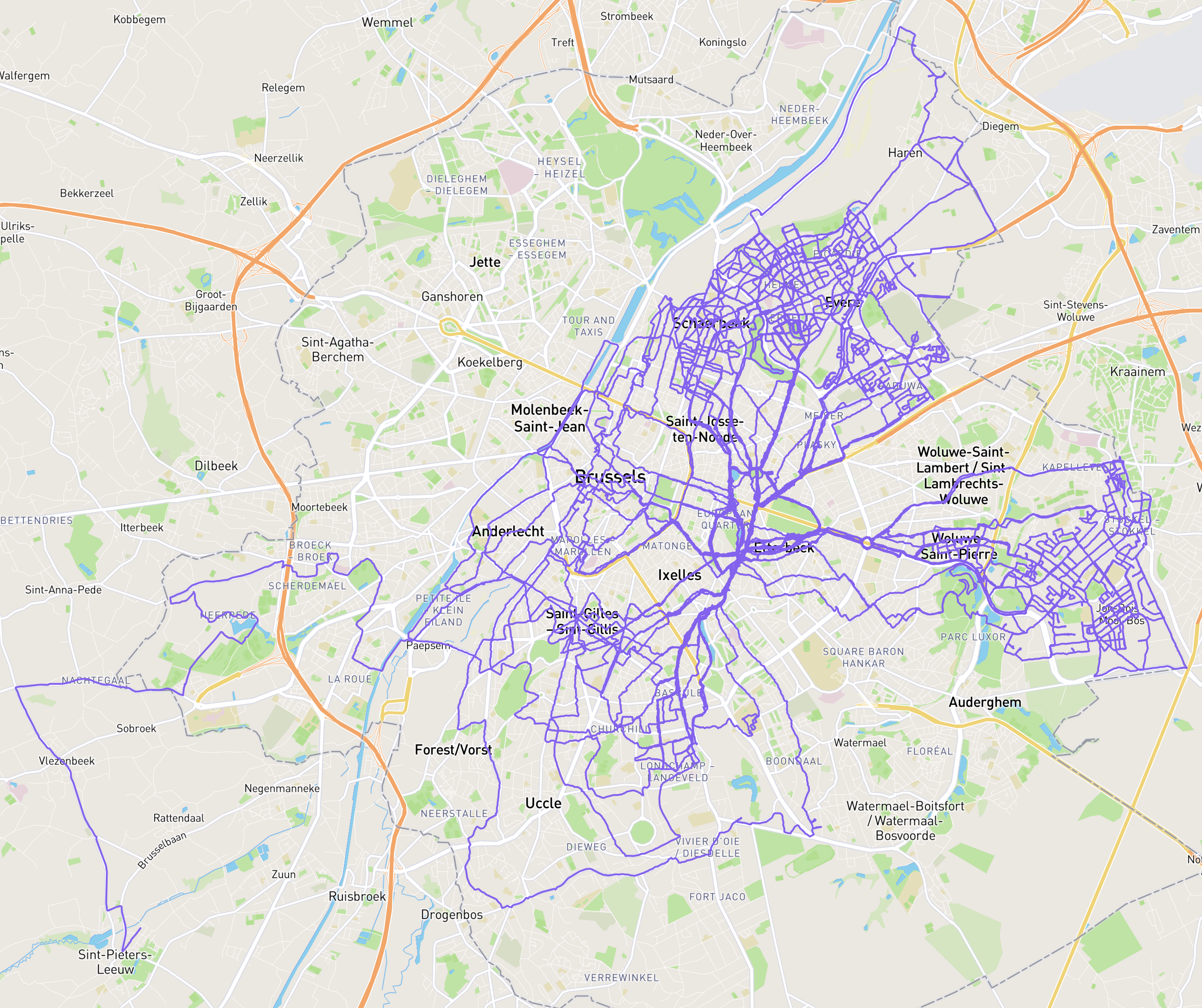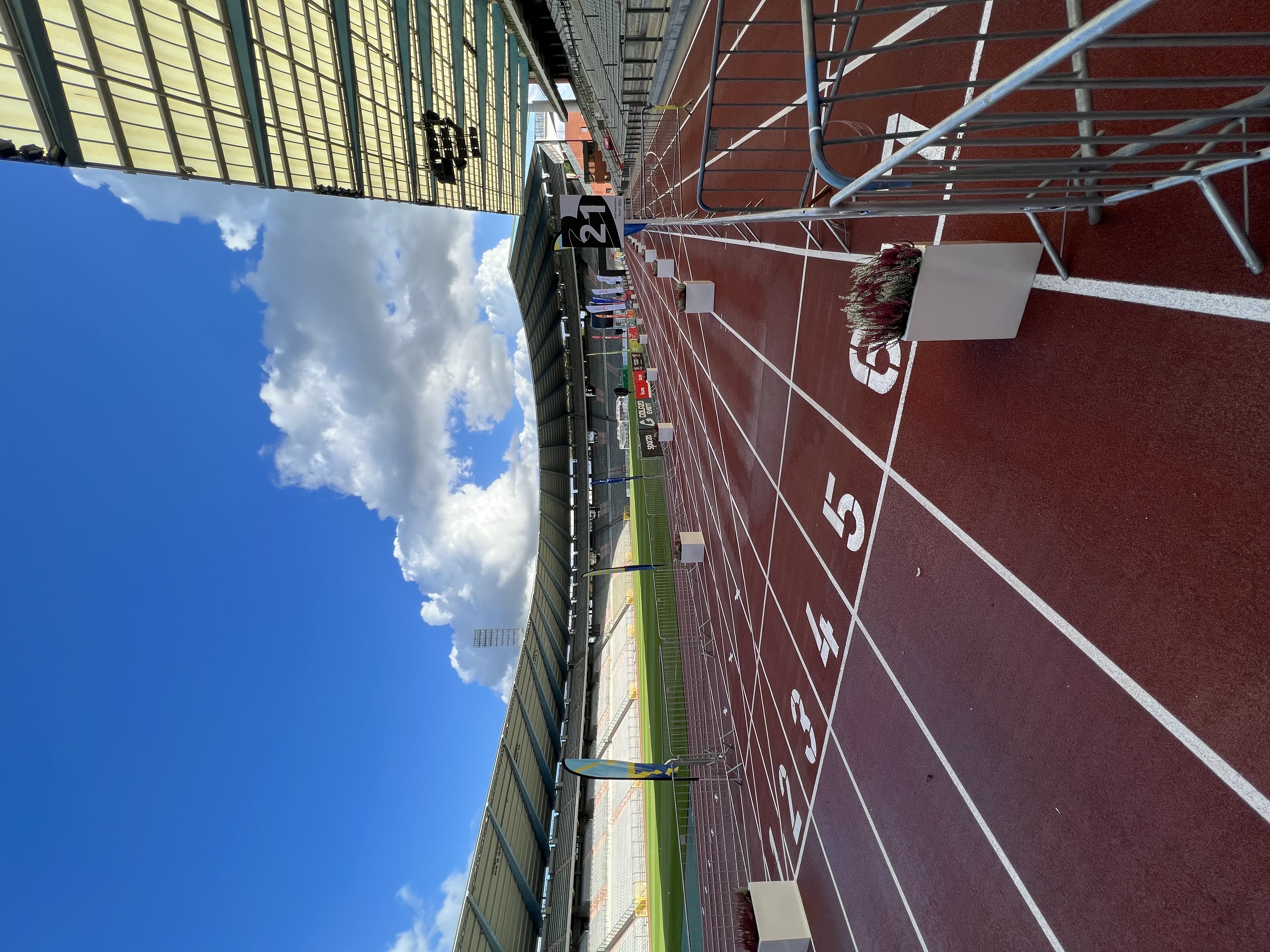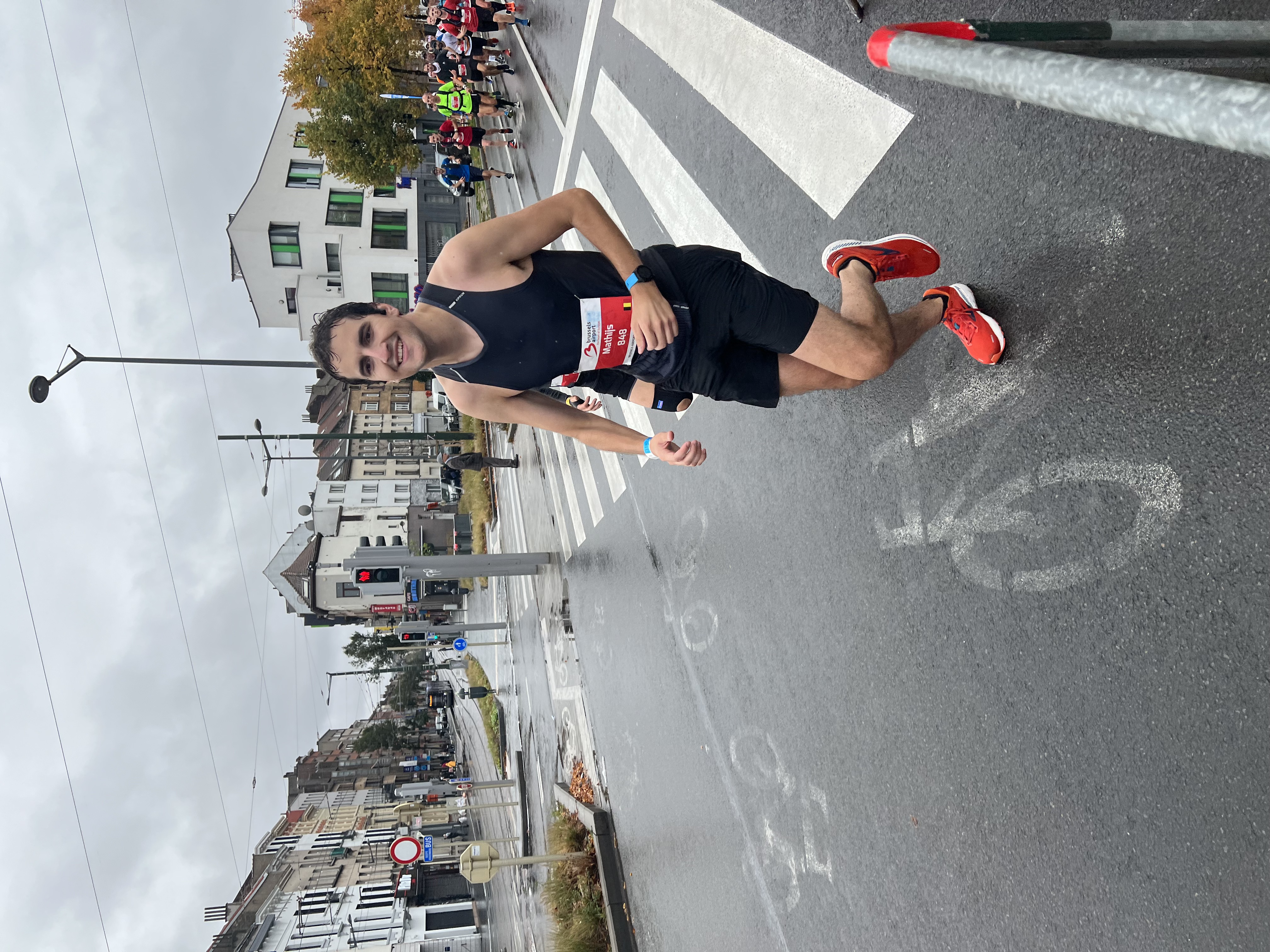Brussels Marathon
After a rather successful 20km of Brussels, I got extremely motivated to run more and foolishly decided to start training for another marathon. I previously ran a marathon in 2017. While successful, the final month of training got me burnt out on running for some time, which is why I held off on training for such a demanding distance again. Nevertheless, I was sufficiently motivated to give marathon training and racing another try. I was also curious to see how the faster times I had been running would translate to the marathon distance.
 Profile picture material.
Profile picture material.
The Course
Based on the training plan I selected, I was looking at racing at the start of October. I therefore once again choose to run the Marathon of Brussels, as its timing fit perfectly into my schedule. While it is not the most ideal course for setting your best time, it is always convenient to race close to home.
The course itself has changed since I ran this marathon last. Instead of following the 20K route with an added detour towards Tervuren, the organizers now opted for a route in the north of Brussels. While the course is not very interesting, sticking mainly to residential and industrial areas, I do appreciate that the organizers tried something new this year.
Click for a scrollable version.
The course itself starts near the Atomium, spending its first few kilometers in the (rather hilly) park of Laken. Afterwards, the course makes a large loop through some residential areas and nearby parks. After this loop, the course veers south, towards Tours & Taxis, to cross over the canal and head into the nearby office district around the Brussels-North station. After passing this area, it heads back north, taking a “there and back again” path next to the canal. After this loop, the course sends runners back towards Laeken, only to send them next to the other side of the canal again. Here the course becomes boring for some time, as it makes runners follow three long, separate “there and back again” lines through various rather boring and ugly industrial zones. After completing this, the course follows the “Van Praet” street next to the royal domain of Laeken, forcing runners up its slow, 2km long climb. After this climb, the course has almost reached its destination, runners only need to cross one final park before they can follow the aptly-named marathon street right into the King Baudouin stadium, where the finish line awaits them.
While the course spends most of its times in rather boring residential and industrial areas, the course does offer spectators various points where they can observe their runner pass by multiple times. As a bonus, some of my friends lived right next to the course, which is always an easy way to get some extra motivation. The King Baudouin stadium is also a very iconic place to finish a race.
Training & Preparation
I decided to not make up a half-baked plan this time. Instead, I bought the excellent “Advanced Marathoning” book by Pete Pfitzinger and Scott Douglas and followed one of the training plans therein. Based on my running habits, remaining time until the race and schedule, I selected the lowest mileage 12 week plan in the book and changed very little. The only change I made to the plan was to move a single tune-up race a day earlier to coincide with a local race; I adjusted the workouts around this race a bit accordingly.
The final planning ended up looking as follows (Mondays were rest days and are therefore not shown):
Before I started, this plan seemed fairly ambitious: the book mentioned that the training should be achievable if one could run the first week without issues; as a rule of thumb, a runner should have a weekly mileage of at least 40K and be able to run the long run of the first week (a 21K run at marathon pace) without issues. This seemed doable based on the mileage I was running before the 20km of Brussels. However, right before starting my training in July, I went on a rather long trip, which cut through my training volume. Worse, I managed to catch COVID the week before I was supposed to get started. As the cherry on top of the cake, my country was going through yet another heatwave the week I started training. In short, I got the perfect mix for messing up my training.
Luckily, I managed to complete every single session on the schedule I set myself in spite of the poor circumstances. I was a bit worried about injuring myself at various points throughout my training, but I managed to get through in the end. Unlike the last time I trained for the marathon distance, I remained motivated to train for the marathon until the very last day. I only had a few days where I got sick of training after a disappointing tune-up race. At the time, the fact that I never missed a single session was enough to get me to stick to the schedule I set for myself. A few sessions later, I was motivated to keep training again.
 All my training runs on a map.
All my training runs on a map.
The book also recommended adding some core, strength and flexibility work to your running training. While I managed to stretch twice a week as recommended, I did not manage to consistently do the recommended strength and core workouts.
Strategy & Goals
Given the time since my last marathon and the huge chunk of extra training I put in, I was completely unsure about the time I could expect to run. This made it difficult to set a goal time / pace. Based on the pace I ran during my final 32K run and some questionable math, I figured a time of 3:15 was a highly optimistic, yet achievable goal. Since there was a 3:15 pace group, I figured I could start by following that group and adjust my pace accordingly if needed. It would be vital to monitor my heart rate and pace while running, as I was very worried about going out slightly too fast and paying for it in the final few kilometres of the race (which is exactly what happened in 2017). After many doubts, I settled to try to hit the 3:15 goal time. I figured I’d be extremely happy if I managed to finish that fast, if I had to slow down I’d still be fairly happy if I managed to finish sub 3:20. With my strategy decided, it was time to get ready to race.
Race Week
A stressful week at work with many deadlines did not lend itself to a great taper. I tried my hardest to sleep well (though not very successfully) and swore of alcohol and coffee for the week. The latter was particularly hard, as the start of a new academic year is exactly the kind of moment where a good dose of caffeine is very welcome.
Three days before the race, I started carb loading, stuffing myself with pasta and rice multiple times a day. Starting this got me in the “big race happening soon” mindset, which is always fun. The hype really commenced when I visited the area around the finish line to pick up my start number on Saturday.
 A perfect location to finish
A perfect location to finish
Unfortunately, this mindset also made it very difficult for me to get some sleep. All in all, I only slept for a bit less than 5 hours on race day. Given the lack of sleep during the rest of the week, I ended up not being as well rested as I wanted to come race day.
Race Day
I got up early, ate some cereal to top of my glucose stores, tried to sleep a bit more, failed, and started getting ready. I had created a fairly detailed plan for race day and I followed it pretty well, which means that I got to the start line warmed up and ready by 8:50. I went much further front than last time and settled in with the pace group for 3:15. I only saw a few dozen people around and in front of me, which made me a bit worried about the goal I had set myself, but I decided to stick to my plan. 15 minutes later, the race started, a few minutes behind schedule.
The first few kilometres were fairly uneventful. I settled in behind the pacers, shuffling around inside the group from time to time. I usually don’t follow pacer groups, opting to follow my own pace, so sticking in this large group was a new and interesting experience. The pacers took it fairly fast, which means that my first few kilometres flew by rather smoothly.
| km 1 | 4:20 |
| km 2 | 4:37 |
| km 3 | 4:29 |
| km 4 | 4:26 |
At the first drinking post, I noticed the first downside of a pace group which is the extra people you have to contend with at resupply posts. This was especially a hassle for me, since I was counting on getting additional sugar from the sports drinks that were handed out at the aid stations. This sugar served two purposes: it would ensure my carb stores would last until the end of the race while also keeping my sugar level up to a decent level.
At kilometre 5, I saw my little fan crew (girlfriend and parents, as usual, this time with my sister’s kids joining for extra loud cheers!) for the first time. I threw my arm warmers to my girlfriend and sped on, happy to see some familiar faces.
| km 5 | 4:20 |
| km 6 | 4:14 |
| km 7 | 4:31 |
At kilometre 7, I was looking around for a friend who may come by to say hi. I saw a couple with a kid, excitedly waving and pointing to them, only to realise it was, in fact, not my friend, but just people being kind enough to clap for us. Luckily, I was running fast enough to avoid facing that awkward realisation.
The next few kilometres were fairly uneventful. I stuck to the pacer group and noticed the pacers seemed to be going a bit too fast for their goal pace, but since my heart rate was at the lower end or even below the range I planned to run at I did not mind this so much.
| km 8 | 4:31 |
| km 9 | 4:35 |
| km 10 | 4:32 |
| km 11 | 4:52 |
| km 12 | 4:30 |
| km 13 | 4:30 |
| km 14 | 4:40 |
| km 15 | 4:35 |
| km 16 | 4:42 |
After 16 kilometres or so, the pacers seemed to be slowing down. I assume they noticed they were running a bit faster than their goal pace. I was, however, doing very fine at the 4:32/km pace they were running at before, so I decided to break away from the pacer group and go at it on my own. I slowly ran away from them, ensuring my heart rate stayed at the lower end of my planned HR range, while keeping an eye on my pace. During this time, I stuck to a few smaller groups of runners who seemed to be running at or close to my new pace. This mainly helped to keep me out of the wind. While the pace group was not far behind, it was nice to strike out on my own and perhaps head for a sub 3:15 time. Striking out on my own also made it much nicer to head through the aid stations, as the runners ahead of me were so spread out that we rarely passed through an aid station with more than 4 people at a time.
 Wet but content.
Wet but content.
| km 17 | 4:31 |
| km 18 | 4:37 |
| km 19 | 4:30 |
| km 20 | 4:37 |
| km 21 | 4:30 |
By the halfway point, I had not gained that much ground on the pacer group, which seemed to come close to me, only to reappear right after several times. I did notice my legs were getting a bit sour at this point. I wondered if the heat during my LT sessions made them less effective at training my legs for this purpose, but stuck to my pace, finding confidence in my heart rate, which was still right where I wanted it.
| km 22 | 4:43 |
| km 23 | 4:44 |
| km 24 | 4:31 |
| km 25 | 4:34 |
| km 26 | 4:33 |
At kilometre 27, the course hit it’s first long there-and-back-again section, following a broad road which passed through industry terrains. The lack of anybody or anything around me made this part of the race dull. Dull times are, of course, an excellent time for the various pains that have been building up to be reinforced in your head over and over.
| km 27 | 4:38 |
| km 28 | 4:38 |
After turning around at the turnaround point, we were hit by heavy winds, which were helpfully pushing us in our backs earlier. These winds made it very hard to stick to my goal pace. I slowed down, but still needed to work hard to stick to a reasonable pace. Since I was alone at this point, I could not rely on anybody to catch some wind for me. I briefly contemplated slowing down to get back to the pace group, but decided against this, as they were quite a ways behind me at this point.
| km 29 | 4:47 |
| km 30 | 4:47 |
| km 31 | 4:38 |
At 31K, I met my team of supporters for the final time. I had consumed nearly all my gels at this point, so I quickly snatched one out of the hands of my girlfriend, just in case.
After meeting my supporters, the course followed another long there-and-back-again road through a rather empty district. This section was particularly harrowing, as I was all alone, and really starting to feel the fatigue. My heart rate was hanging around the upper end of my planned range, and many parts of my legs did not seem to be happy with the torture I was putting them through. Worse. My stomach was not happy with the many doses of sugar I was ingesting. In spite of this, I pushed on, occasionally passing by another lone runner. I was evidently not the only runner suffering. I saw many people on the other side of the course walk, including a pacer from the 3:00 group.
| km 32 | 4:40 |
| km 33 | 4:40 |
| km 34 | 4:39 |
When I turned around and hit the wind again, the going got really really hard. I was in pain, my heart rate was high, I was nauseous from the gels, and the wind was making the going hard. I gritted my teeth and tried to push through, trying to ignore the (now much smaller) 3:15 pace group that was approaching close behind me.
| km 35 | 4:47 |
| km 36 | 4:53 |
| km 37 | 4:50 |
The pace group was pushing for an even pace, not an even effort, and thus pushed ahead through the heavy wind. I, on the other hand, did not manage to stick to my goal pace at this point. As such, after about 36 kilometres, the pace group caught up with me. I tried to stick with the pace group, using them to break the wind for me, but I was too tired at this point, after a few minutes of raising my heart rate trying to keep up, I had to let them go. This was a rather heavy blow to my determination, as I realised it would mean I would miss my goal time. I spent too much energy trying to chase the pace group and, in spite of my intentions not to when I started the race, decided to walk for a few metres.
| km 38 | 5:40 |
A few metres further, a spectator, seeing my struggle, cheered me on, which got me going again, albeit at a slower pace. At this point, I hit the crowd of people running the half-marathon. Having some people around me made it easier to keep going. However, when I hit the climb of the Van Praet street, I could not help but walk again. While walking, I checked my sugar, which had, apparently, dropped fairly low, in spite of the gels, sports drinks and bananas I forced myself to eat while running. While this partly explained the lack of power in my legs, this also got me incredibly frustrated.
| km 39 | 6:55 |
After walking for a bit, I started running again. The final few kilometres were torture. My stomach and lower legs were not happy when I had to climb, my upper legs were burning when I had to descend. Determined to salvage what I could, I forced myself to run the final few kilometres without walking. I got within sight of the King Baudouin stadium, and used the energy of the crowd to carry me through the final few metres.
| km 40 | 5:02 |
| km 41 | 4:54 |
| km 42 | 5:04 |
 Happy to finish.
Happy to finish.
Results
I ended up finishing in 3:20:34. That’s 103rd out of 1113 finishers, 21st in my age group.
| Year | Time | Links |
|---|---|---|
| 2017 | 3:42:03 | strava, report |
| 2022 | 3:20:34 | strava, report |
While a lot faster than my previous marathon time, I was pretty disappointed by missing both my sub 3:15 and 3:20 goal. I especially feel that I could have improved this time somewhat if there was less wind, if I had slept a bit better, or if I had less issues with my sugar.
In retrospect, I should have probably recognised my legs not being in the best possible shape a bit earlier in the race; sticking to the pace group might have tired me out less, to the point that I could have held on a bit longer. I evidently did push myself too hard in many ways. I could hardly stand on my legs after finishing, and my stomach was also not happy, I, once again, ended up emptying its contents in a Brussels garbage bin. That may be partly to blame on my celebratory post-marathon beer. Nevertheless, the post-marathon puke in a garbage bin seems to be becoming a tradition.
In better news, after my last marathon, I got burnt out on running for a while, hardly going out for a run for two months or so. While I am going to take a few days off from running, today’s experience did not damper my appetite for more training. Instead, I am eager to try and break the 3:15 barrier in some future marathon.